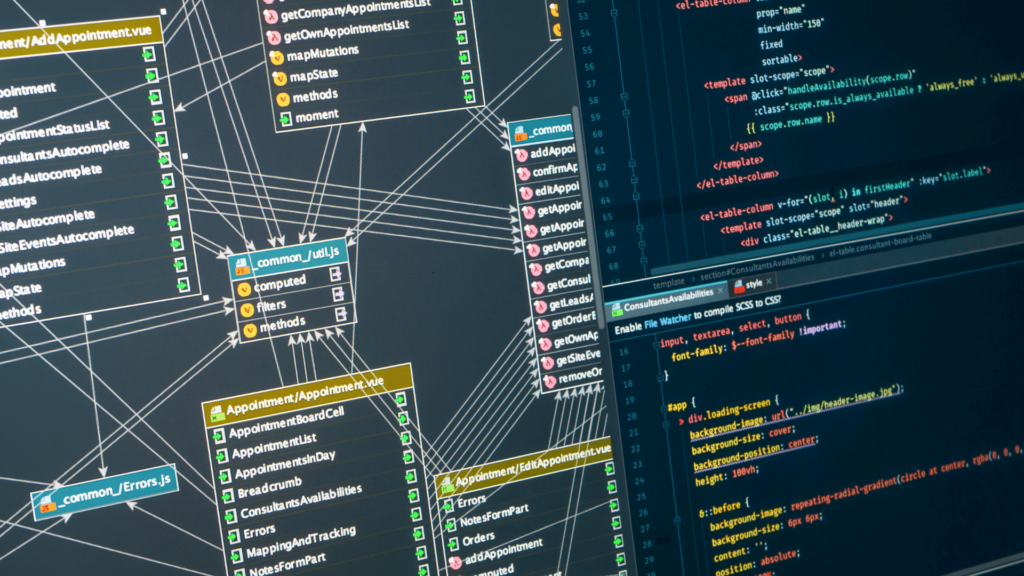Enterprise Custom Software
Enterprise Custom Software is designed and developed to meet the specific needs of an enterprise. Unlike standard software, it fully aligns with the business’s processes, goals, and strategies. This alignment boosts efficiency, flexibility, and competitiveness.
Specialized software helps businesses bring new ideas to life, build entirely innovative business models, enhance existing structures, and gain a larger market share by surpassing competitors.

We can examine the main differences between enterprise software and ready-made package programs under the following headings:
1. Personalization and Compatibility
Ready-Made Software: Designed for general use, making customization for specific industries or businesses challenging.
Custom Software: Fully tailored to your business needs and seamlessly integrates with all processes.
2. Cost and Investment
Ready-Made Software: Initially more affordable, but long-term expenses may arise from licenses, updates, and additional features.
Custom Software: Requires a higher initial investment but eliminates recurring license fees and enhances efficiency through business-specific solutions.
3. Scalability
Ready-Made Software: Comes with limitations and may struggle to accommodate business growth.
Custom Software: Easily scalable, allowing new features to be added as your business expands.
4. Security and Data Control
Ready-Made Software: Provided by third-party companies, potentially leading to security vulnerabilities and data privacy risks.
Custom Software: Built with tailored security measures, ensuring complete control over your data.
5. Technical Support and Updates
Ready-Made Software: Limited to standard manufacturer support, with updates rolled out universally for all users.
Custom Software: Offers direct support from your development team, with updates and improvements aligned with your business needs.
6. Integration Capability
Ready-Made Software: May require additional software to integrate with existing systems.
Custom Software: Designed for seamless integration with your company’s existing infrastructure.
Conclusion
While ready-made software provides quick solutions for standard needs, Enterprise Custom Software delivers a more efficient and profitable long-term solution by fully adapting to your business requirements. If your business has unique processes and needs, custom software is the smarter choice.
What are the biggest problems preventing your business from growing? How can custom software overcome them?
The main obstacles to business growth typically fall into the following categories: Inefficient Business Processes, Customer Management and Experience, Scaling Issues, Lack of Data Management and Analytics, Communication and Team Coordination, and Lack of Competitive Advantage.
1. Inefficient Business Processes
Challenges: Time-consuming manual processes, lack of coordination, and insufficient automation.
Custom Software Solution: Automates workflows, reduces manual errors, and accelerates operations.
2. Customer Management and Experience
Challenges: Customer dissatisfaction, lack of personalized service, and inefficient tracking systems.
Custom Software Solution: CRM systems centralize and analyze customer data, enhancing personalized interactions.
3. Scaling Issues
Challenges: Inability to meet growing demands, performance bottlenecks, and integration limitations.
Custom Software Solution: Scalable systems optimized specifically for your business to ensure seamless growth.
4. Lack of Data Management and Analytics
Challenges: Data loss, disorganized records, and lack of real-time insights for strategic decisions.
Custom Software Solution: AI-powered analytics and big data solutions enhance data processing and decision-making.
5. Communication and Team Coordination
Challenges: Poor internal communication, ineffective collaboration tools, and inadequate remote work systems.
Custom Software Solution: Project management and internal communication platforms improve teamwork and efficiency.
6. Lack of Competitive Advantage
Challenges: Falling behind competitors and limitations of standard software solutions.
Custom Software Solution: Tailored solutions give your business a competitive edge with industry-specific features.
By addressing these challenges with custom software, businesses can achieve greater efficiency, scalability, and long-term success. 🚀

Enterprise Custom Software Examples and Situation Assessment
If large e-commerce platforms like Hepsiburada and Trendyol had been built using off-the-shelf e-commerce software, they would have encountered the following challenges:
1. Scalability and Performance Issues
Off-the-shelf e-commerce software is designed to manage a limited number of products, orders and users. But a large-scale platform:
- Supporting millions of products and vendors,
- Managing heavy order traffic,
- Preventing system crashes during instant campaigns and discounts,
- For global operations, it needsto adapt to different currency and payment systems.
Custom software is designed to be scalable to these requirements, while off-the-shelf systems often cannot scale beyond a certain size.
2. Lack of Flexibility and Personalization
Large e-commerce companies are constantly developing new features to improve the customer experience and optimize their marketing strategies. However, adding these features is either not possible or requires high additional costs. For example:
- Trendyol’s structure, which includes different business models such as“Fast Market”, “Wallet” and “Trendyol Go”, would not be possible to create with package programs.
- Hepsiburada’s systems such as“Hepsiburada Premium”, “Hepsipay” and vendor panel integrations can only be developed with custom software.
If these platforms used packaged software, they would not be able to differentiate themselves from their competitors and stand out in the market.
3. The Challenge of Achieving Technological Superiority
In order to stay ahead in the highly competitive e-commerce sector, it is necessary to quickly adapt to new technologies.
- AI-powered product recommendations,
- Dynamic pricing with big data analysis,
- Personalized campaigns,
- Advanced logistics and inventory management,
- Features such asautomation of customer support systems (chatbots, voice assistants) are only possible with custom software.
Off-the-shelf systems often cannot integrate such advanced technologies or offer very limited features. With specialized software, these innovations can be developed quickly and tailor-made.
4. Loss of Competitive Advantage
Platforms such as Hepsiburada and Trendyol maintain their leading positions in the marketby offering a better user experience than their competitors. But if a packaged software was used:
- They would be at the same level as competitors using the same software,
- It would be difficult to add innovative features,
- There would be no flexibility to improve the user experience.
As a result, it would be impossible to differentiate and take the lead in the market.
Large Scale Success Not Possible Without Custom Software
If e-commerce giants like Hepsiburada and Trendyol had started out with package programs:
- They would not have been able to create a scalable structure and their systems would have been blocked after reaching a certain size.
- They could not adapt quickly to technological innovations and would be weak against their competitors.
- They would not be able to personalize the customer experience and build a loyal customer base.
- They wouldn’t have a competitive advantage and would struggle to gain a foothold in the market.
Developing custom software is a mustfor startups looking to build a large-scale e-commerce platform . Standard solutions are only suitable for small businesses and startups with simple needs.
Application Areas

Enterprise custom software can be used in almost any industry and business process, as it is tailored to the specific needs of a business. Here are some common application areas:
1. Human Resource Management
Enterprise-specific software automates human resources activities such as personnel management, payroll, performance evaluations and training processes. In this way, businesses can manage their human resources processes more efficiently.
2. Customer Relationship Management (CRM)
Special software is used to strengthen customer relations and optimize sales processes. By collecting customer data in a centralized system, this software enables the development of strategies to increase customer satisfaction.
3. Production and Supply Chain Management
Enterprise-specific software plays a major role in areas such as production process planning, inventory management and supply chain optimization. This software reduces production costs and speeds up delivery processes.
4. Finance and Accounting Management
Accounting processes such as tracking financial transactions, budget management, tax calculations and reporting can be easily managed with specialized software. This enables businesses to make financial decisions in a healthier way.
5. Project Management
Enterprise-specific software supports project management processes such as project planning, resource management, timelines and budget tracking. In this way, projects are carried out more effectively.
6. E-Commerce and Online Sales Platforms
E-commerce businesses need specialized software to enhance customer experience and optimize sales processes. These software facilitate product management, order tracking and payment processes.
7. Data Analytics and Reporting
Big data analysis and reporting play a critical role in helping businesses make strategic decisions. Enterprise-specific software helps businesses plan for the future by transforming data into meaningful information.
8. Health and Pharmaceutical Industry
Healthcare organizations benefit from special software in processes such as patient record management, appointment systems and medication tracking. This software increases patient satisfaction and improves operational efficiency.
9. Training and Learning Management
Educational institutions use specialized software in processes such as student information systems, course programs and exam management. This software makes training processes more effective.
10. Logistics and Transportation
Logistics companies need special software for processes such as vehicle tracking, route optimization and inventory management. These software reduce logistics costs and speed up delivery processes.
Advantages
- Flexibility: Can be customized according to the needs of the business.
- Efficiency: Accelerates operational processes and reduces costs.
- Competitive Advantage: Enables businesses to get ahead of their competitors.
- Security: Ensures data security and privacy.
- Scalability: As the business grows, so can the software.
In summary, enterprise-specific software can be used in almost every sector and business process because it is designed specifically for the needs of a business. With this software, business processes are automated, productivity is increased, error rates are reduced and competitive advantage is gained.
Disadvantages
Custom Software May Cost More
Since Enterprise Custom Software is developed from scratch according to the individual needs of businesses, it is generally more costly than ready-made package programs. The main reasons for this are as follows:
- Customization Efforts: Since every business has different needs, custom software must be fully customized according to these needs. This requires additional development and testing processes.
- Development Time: While off-the-shelf programs are ready to use immediately because they are already available, custom software takes time to develop. This time may vary depending on the complexity of the software and the size of the business.
- Team Cost: A team of software engineers, designers, project managers, etc. is required to develop personalized software. The salaries and other expenses of this team increase the total cost.
- Maintenance and Support: Software needs to be constantly updated, bugs fixed and user support provided. This results in additional costs.
Potential Risks and Management of Custom Software Development
Although customized enterprise software development offers many advantages, it also brings some risks:
- Budget Overrun: Exceeding the budget set at the beginning of the project is a common risk. To manage this risk, a detailed project plan should be created and the budget should be monitored regularly.
- Time Overrun: There may be delays in the delivery date of the project. This may negatively affect the business processes of the organization. To manage the risk, a realistic project schedule should be created and regularly updated.
- Quality Issues: If the software developed is not of the expected quality, it can be a major problem for the business. To manage this risk, quality control processes should be established and the software should be tested frequently.
- Security Vulnerabilities: The risk of security vulnerabilities may be higher in custom software. To manage this risk, it is important to develop in accordance with security standards and perform regular security scans.
How to Choose the Right Custom Software Company?
Choosing the right software company is critical to the success of the project. Here are some points to consider:
- Experience: Find out if the company has a successful track record in similar projects.
- References: Review the company’s references and interview previous clients.
- Technological Capability: Learn about the company’s technologies and development methods.
- Project Management: Learn about the company’s project management processes.
- Support Services: Get information about the support services to be provided after the launch of the software.
- Cost: Determine the most appropriate cost by comparing the offers of different companies (price, infrastructure, quality, duration, support, etc.).
- Privacy: Find out what measures the provider takes regarding data security and privacy.
As a result , althoughEnterprise Custom Software development provides many advantages to businesses, it also brings some risks that need to be careful. With the right choice of provider and effective project management, these risks can be minimized and the advantages offered by custom software can be maximized. As Codinic, we determine the most suitable technology for you and develop professional applications that can have a say in the world market with all the features needed.
How to Determine the Costs of Specialized Software?
Since Enterprise Custom Software is developed from scratch according to the individual needs of businesses, it is generally more costly than ready-made package programs. However, this does not mean that custom software is always more expensive. The cost can vary depending on many factors. For more details on software costs, you can check our article here.
Factors Affecting Personalized Software Costs
- Complexity of the software: The features of the software, the systems to be integrated and the technologies to be used directly affect the cost.
- Development Time: Depending on the size and complexity of the project, the development time increases and this increases the cost.
- Number of Teams and Expertise: The number and experience level of experts such as software developers, designers and project managers who will take part in the project affect the cost.
- Technologies: The license fees of the technologies to be used may incur additional costs such as cloud services.
- Support and Maintenance: Updates, bug fixes and user support after the software is rolled out can increase costs.
- Change Requests: Additional features or changes that arise during the project process can increase the cost.
Calculating the Cost of Custom Software
The cost of software is usually calculated in the following ways:
- Hourly Rate: Charging software developers by the hour. In this method, the total number of hours required to complete the project is determined and the cost is calculated by multiplying this number by the hourly rate of the developer.
- Fixed Fee: A fixed price is set for the project. In this method, the scope of the project must be clearly defined.
- Material Cost + Labor Cost: The cost is calculated by adding the cost of materials such as hardware and software licenses used in software development and the wages of software developers.
Custom Software or Ready Package Software?
Which is more suitable depends on factors such as the size of the business, budget, needs and future plans.
- Ready Packaged Software: Faster out-of-the-box, generally more cost-effective but with limited customization options.
- Custom Software: It adapts exactly to the needs of the business, but the development time and cost can be higher.
Tips to Reduce Custom Software Costs
- Clear Project Scope: Avoid unnecessary features.
- Choose a Flexible Technology Stack: Consider using open source technologies.
- Agile Methodology: This methodology enables faster and more flexible development.
- Cloud Services: Cloud infrastructure can reduce costs.
- Collaboration within a Team: Efficient teamwork saves time and costs.
As a result, the cost of Enterprise Custom Software can vary depending on the complexity of the project, the technologies used and other factors. However, custom software can bring significant benefits to businesses in the long run. Therefore, it is important to conduct a cost-benefit analysis comparing different options to make the right decision.
For more detailed information about custom software costs, you can get support from Codinic software consultants by clicking here.


